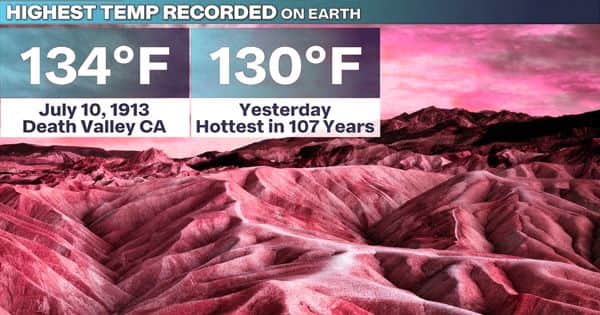Verify the Hottest Temperatures on Earth
Death Valley hits 130° F, the hottest recorded temperature on Earth since 1931. A blistering 130-degree Fahrenheit (54.4 degrees Celsius) temperature reading in Death Valley, California, on August 16th quickly made headlines, but it could take months or even years before the number can officially break world records. If the temperature is verified, it will become the third hottest temperature ever recorded on Earth and the hottest temperature recorded on the planet since 1931. If verified by the World Meteorological Organization, or WMO, that temperature will be the hottest recorded since 1931, and the third hottest since record-keeping began.
Verifying that number, however, is a complex process that can come with a lot of controversies. The verification process for such global records of weather extremes, which are archived at WMO, may take months, says archive chief Randall Cerveny, a meteorologist at Arizona State University in Tempe. In the past, it’s involved shipping instruments across the globe, assembling teams of experts, and, in one case, fleeing gunfire during an ongoing revolution. There is precedent for previous records being dismissed once disproven. It also involves intense scrutiny from weather experts around the world — all with their own interpretations of which temperatures should actually stand the test of time. In 2012, WMO determined that what was then thought to be the hottest recorded temperature, a 1912 observation of 57.8° C (136° F) in Libya, was not valid.
The World Meteorological Organization (WMO) has already started organizing a panel of atmospheric scientists to carefully examine the observation, said Randy Cerveny, the agency’s rapporteur (or lead reporter) for extreme records. “People love to argue about weather records. It’s part of the nature of the beast, I guess,” Randall Cerveny, weather and climate extremes rapporteur for the World Meteorological Association (WMO), says with a chuckle. After months of scrutiny, Cerveny will ultimately make the call on whether to accept the recent Death Valley reading into the WMO’s global Archive of Weather and Climate Extremes. That’s “a testament to the high-quality and rigorous evaluation process handled by some of the top atmospheric scientists in the world,” he said.

Fig: Death Valley has the hottest temperature on Earth
To vet the Death Valley temperature, the WMO will first need to bring together an international team of top scientists. They’re given a background report to examine that includes details on the location where the temperature was recorded, the type of equipment used, regional weather conditions during the time of the observation, and any other pertinent information. There are strict standards for how temperatures should be taken. For example, the sensor needs to be shaded and lifted above the ground to avoid getting an observation that’s misleadingly hot.
These 21st-century observations have the benefit of such close scrutiny and modern technology. Over the years, the process of vetting weather extremes has become more rigorous. A new step was added last year: transporting the equipment that took the observation to a lab to test it. Around the globe, extreme or high-temperature records will likely be continually set this century. The first time this was done by the WMO was in 2019 to verify the current third and fourth highest temperatures recorded on Earth. Sensors were shipped to a lab in Italy from Mitribah, Kuwait, which recorded a temperature of 53.9 degrees Celsius (129.02 degrees Fahrenheit) in July 2016; and from Turbat, Pakistan, which recorded a 53.7 degrees Celsius (128.66 degrees Fahrenheit) temperature in May 2017. The whole process is expected to take six to nine months at a minimum but bears in mind that it took two to three years to verify the temperatures in Kuwait and Pakistan. In its most intensive evaluation ever undertaken, the WMO Archive of Weather and Climate Extremes has verified the Mitribah observation as 53.9 °C (± 0.1 °C margin of uncertainty) and the Turbat one as 53.7 °C (± 0.4 °C). Significantly, they are the highest, officially-recognized temperatures to have been recorded in the last 76 years.
It can take just as long, or longer, to take a record off the books. El Azizia, Libya, once held the title of the hottest temperature ever measured, 58 degrees Celsius (136.4 degrees Fahrenheit), recorded in 1922. Then in 2010, a WMO committee launched an investigation into the record that ended up coinciding with the 2011 Libyan revolution. “One of our members who was part of the Libyan government at that time literally had to exit Tripoli with his family with guns firing over his head,” Cerveny says.
Now the reigning world champion when it comes to heat extremes is a 134 degrees Fahrenheit (56.7 degrees Celsius) observation taken in Death Valley in 1913. That record is also hotly contested. A 2016 analysis published on the blog Weather Underground picked apart the observation, making the claim that it wasn’t consistent with local weather at the time and didn’t match up with readings from nearby weather stations. Full details of the assessment are given in the on-line issue of the International Journal of Climatology published on 17 June 2019.
This evaluation is unique in that the committee recommended that both sensors be independently calibrated and simultaneously compared to ensure that the data were as accurately obtained as possible. Because of human error and instrument error, “There’s no such thing as a long term temperature record that’s perfect,” Reid told The Verge on a call he took poolside in Death Valley. Reid raced to Death Valley, a more than four-hour trek from his home near Los Angeles, to take his own readings after the potentially record-breaking news came out.
Reid’s investigation into the 1913 record hasn’t been formally reviewed by other scientists, and Cerveny says he hasn’t yet seen enough evidence for the WMO to take a look into it. The investigating committee was composed of metrology (instrument) and climate experts from Italy, Kuwait, Pakistan, Saudi Arabia, France, Spain, Morocco, Egypt, Turkey, Armenia, Iran, Australia, United States, and the United Kingdom.
















